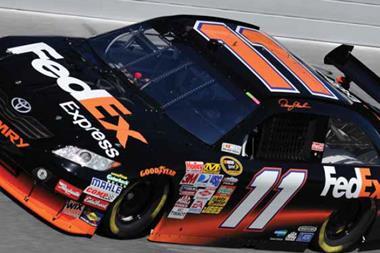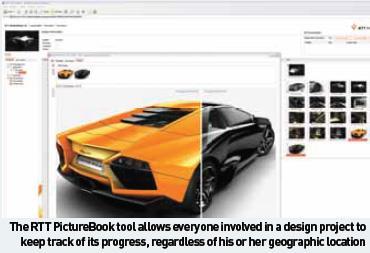OEMs and suppliers are using an increasing range of systems to support their CAD data management and product lifecycle applications. Parametric Technology Corporation has recently enhanced its product offering improved cycle times and product development
We’re used to seeing Unigraphics (UG) and Catia leading the charge in the CAD/ PLM departments of automotive OEMs and Tier Ones, but a company often overlooked is Parametric Technology Corporation (PTC) with its Pro/ENGINEER and Windchill products.
In the early days, UG (Unigraphics NX as it is now known) and Catia shared the big three automotive OEMs with Computervision (CV). Chrysler was Catia, GM Unigraphics and Ford was CV. Things took a turn when SDRC entered the fray, announcing a strategic partnership with Ford in 1995. In 1998 PTC took over Computervision in an effort to regain the initiative at Ford. This did not happen and PTC has been trying to gain major OEM business ever since.
The vast CV automotive user base means PTC still has lots of good ‘also ran’ business, including companies such as: Ferrari (powertrain), Maserati, Fiat, Toyota, VW, Audi, Webasto, Harman/Becker and, more recently, Grand River Group and FAW in China.
Besides the usual geometry generation and manipulation applications, PTC has a real PLM ‘silver bullet’ in Windchill – their industry leading Enterprise Product Data Management (PDM) solution; many of the key installations at VW and Toyota are based around Windchill.
This year, Toyota Motors deployed Windchill from PTC as the platform for CAD data management and product lifecycle management (PLM) at its powertrain division. The implementation is part of Toyota’s target to establish a multi-CAD environment allowing the automaker to manage various dissimilar CAD data formats with a single bill of materials (BOM) by bridging multiple CAD systems and the BOM.
Toyota is developing the bridging software itself. The company had been using PTC’s Pro/INTRALINK for the data management but the decision to deploy Windchill was made because PTC recently included Pro/INTRALINK functionality in Windchill to align the basic designs, enabling significant increase in usability and scalability, and much better performance in a LAN (Local Area Network) environment.
When the powertrain division’s CAD data management and PLM is totally controlled with Windchill, better design efficiency and shortened design cycles are anticipated.
Toyota’s body design division is using IBM/Dassault’s Catia V5 while developing their PLM around IBM/ Dassault’s Enovia product.
“As for the design/data management for body design and powertrain, it’s better to have independent systems that allow for optimum efficiency, taking into account individual characteristics, amounts of data and required performance,” says Yoshikazu Amano, Managing Director, Engineering Information Management, Toyota Corporate IT Group. “However, we would like to accommodate all the CAD data with a single BOM within four to five years.” This suggests the existing multi-CAD, multi-PLM strategy to be effective for the time being. Toyota Powertrain also uses PTC’s Pro/ENGINEER Wildfire 2.0 CAD solution. This is the Toyota Powertrain development standard, incorporating dozens of improvements for powertrain development, which Toyota and PTC conceived and developed over recent months. The deployment is a part of a multi-year, joint process redesign and development initiative that PTC and Toyota signed in May 2003.
Since standardising on Pro/ENGINEER for powertrain in 2002, Toyota has achieved improvements in design cycle time, introduced new lean product development techniques, and increased its leadership in the areas of continuous improvement, quality and technical innovation. This phase builds on that success by introducing innovative new PLM technology into their process in 3D engineering, analysis, manufacturing planning, drawing creation and interoperability.
 “PTC has been a skilled and experienced partner to us throughout this major undertaking,” says Amano.
“PTC has been a skilled and experienced partner to us throughout this major undertaking,” says Amano.
“PTC’s comprehensive Product Development System clearly aligns with Toyota’s approach to product design and development, and we anticipate significant benefits to our process through this deployment.”
Toyota is well known for its obsessive focus on engineering and manufacturing excellence and the adoption of PTC by Toyota is a validation of the PTC vision, their approach and their software. Toyota’s standardisation on Pro/ENGINEER Wildfire 2.0 reinforces PTC’s special focus on the powertrain segment of the transportation industry.
More than one third of the top 40 automakers use Pro/ENGINEER as the basis for their CAD/PLM implementations for powertrain development. They include: VW, BMW, Hyundai, Fiat, Volvo Truck, Daihatsu, Hino Motors, Tata Motors, ZF, Mannesman, Visteon, Robert Bosch, Eaton, Dana, AVL and Cummins. By virtue of its overall architecture, interaction methodology and software features, Pro/ENGINEER is particularly suited to powertrain design while also providing other users with a simple, intuitive, and connected experience.
“The deployment of this phase is only the beginning of what Toyota and PTC envision for state-of-the-art design and process improvement,” said PTC Senior Vice President of Product Management, Brian Shepherd. “More joint work is already underway and promises to continue to improve the powertrain product development process even further.”
The Volkswagen Group has expanded its deployment of PTC solutions into all powertrain divisions across the Volkswagen Group to enable global standards for integrated product creation processes within the different brands. Volkswagen expects Windchill to drive substantial improvements in real-time monitoring and documentation of projects. The PTC solutions will be used by more than 3,000 VW employees around the world who will work on a single integral platform for visualization, content and process management, both within the engineering department and throughout the extended enterprise.
“Using PTC solutions to connect design, prototyping and testing within a single product development system, we expect to improve our overall product quality,” says Dr Frank Metzner, Head of Powertrain Module Management at Volkswagen. “Furthermore, we will be able to automate our development processes and monitor projects in real time which will lead to shorter cycle times.”
The Windchill deployment is an expansion of Volkswagen’s current use of the PTC Product Development System, which includes Pro/ENGINEER for 3D design, ProductView for visualization and Windchill for content and process management and collaboration.
The roll-out starts simultaneously within Audi and Volkswagen, followed by Skoda in the Czech Republic. It will also be deployed by VW in the Americas with further international brands like Seat and Lamborghini following suit. Since the end of 2005, PTC’s Windchill has been used by more than 1,200 employees of the Volkswagen and Audi brands.
“The global deployment of PTC solutions is strategically important for us to improve the leverage of existing knowledge and information in the powertrain process in our subsidiaries all over the world,” said Dr Trac Tang, Group PIO Product Process of Volkswagen.
Grand River Group, the leading Chinese motorcycle manufacturer, has successfully integrated its Enterprise Resources Planning (ERP) system, SAP, with PTC Windchill. The speed of this successful integration, completed in just three months, is considered an industry breakthrough. Grand River was able to accomplish this accelerated data integration using Windchill Enterprise System Integration (ESI) for enterprise system integration.
Grand River is China’s top motorcycle manufacturer with about 1.8 million motorcycles manufactured last year. Grand River deployed PTC Windchill ProjectLink and Windchill PDMLink, to build a sophisticated product development system that allowed for better management of product data and team communication.
Motorcycle product development is a highly complex process requiring fast innovation, complex information exchange among multiple departments and extensive prototyping. Additionally, Grand River has very stringent requirements for product quality, including market research, product development, product manufacturing, components supply and customer service. The company requires that data in the product lifecycle should be consistent, accurate and easy-to-trace. This deployment is also positioned to fulfill corporate development strategies and increase corporate management efficiency.
“Before working with PTC, our ERP system and product development processes operated independently. As a result of the integration, it provided a more integrated IT architecture as well as a good foundation to shorten our product development lifecycle,” says Hailan Chen, the Deputy General Manager of Grand River.
“We are extremely pleased with the functionality as well as the flexibility of PTC’s PLM solutions to meet our product development and ERP integration needs.”
Harman/Becker Automotive Systems of Karlsbad, Germany, is expanding its deployment of Windchill ProjectLink and Windchill PDMLink to 1,000 users across the company. Harman/Becker is a leading supplier of Automotive Infotainment Systems and runs several development centres worldwide. It standardised on Pro/ENGINEER as its preferred design solution for mechanical engineering in 1992. The company is using PTC’s Windchill to complete its Product Development System, enabling control of product information and the implementation of global standards for its product development process.
In addition, Harman/Becker’s use of PTC’s Pro/ INTRALINK for Pro/ENGINEER data management will now be migrated to Windchill PDMLink within the next six months. PTC’s Windchill will become the global information backbone to manage Pro/ENGINEER models as well as all project and engineering data management, including the management of other mechanical design content such as Catia V5, and electrical design content such as Mentor Graphics.
“Moving to Windchill PDMLink gives us faster access to product information. It allows us to generate product structure variants, for example country specific product structures, faster and with more flexibility. And it will help us reduce cost by reusing existing product structures which are now much more easier available to other teams,” explains Dr Michael Ruf, Vice President Engineering Europe, Harman/Becker Automotive Systems.
The company expects to increase product reliability by using standardised and automated release processes. “Automating the workflows will help to optimise cross-department processes and shorten cycle times,” adds Dr Karl-Heinz Augenstein, Vice President Quality Management. “We can now easily control each product throughout the whole lifecycle.”
Likewise, German company Webasto has expanded its deployment of Windchill to more than 1,000 users worldwide. Webasto has been using Windchill as its product data management and workflow platform since 2001 and has recently adopted Windchill ProjectLink for project collaboration as well as program management and execution.
The company has almost 6,500 employees worldwide and revenue of $1.85 billion, making it the leading Tier One supplier of roof and heating systems to the international automotive industry. To meet the challenges of a large Tier One organisation Windchill manages the overall change management process for all sites and has become the leading backbone system for the generation of new articles and BOM, closely integrated with Webasto’s local ERP systems. Additionally, Webasto uses Windchill to support its Advanced Product Quality Process (APQP) initiative – a standard quality process prescribed from QS 9000.
PTC is re-engineering the Polyplan software (acquired in June 2005) into their Windchill architecture. The new Link solution (to be launched in the first half of 2007) supports manufacturing process management. MPMLink will be integrated with CAD, with visualization, with PLM and ERP, and with technical publishing, so that the information can flow reliably through the process.
Also key to PTC’s success in the supply chain is their new On Demand service. The new two-tier (Standard and Dedicated) PLM solution has been set up in conjunction with IBM hosting and consulting. The standard product is geared mostly for SMB users, while the dedicated version is meant for larger companies that prefer outsourced IT.
PTC’s PLM On Demand uses PTC software together with IBM middleware, and is hosted at a large IBM facility in Boulder, Colorado. For smaller companies, PLM On Demand offers collaboration, vaulting, and overall management in an environment similar to an ASP (application service provider) model. IBM in conjunction with PTC also offers consulting services to companies that may need to transform their business practices around PLM.
With PTC PLM On Demand non-engineers can participate in the design process using embedded ProductView visualisation to interrogate, validate, and mark up design information.
“Webasto has ambitious goals for growth. In order to continue setting the standard for suppliers to the international automotive industry, we need to employ processes and technologies that enable us to be innovative and efficient at the same time,” says Bernd Göllnitz, CIO of Webasto. “Collaboration has become crucial for us, as our customers increasingly work on cross-brand or crossplatform projects. Windchill enables product development teams from different sites to collaborate more efficiently on global projects. Additionally, Windchill has improved our ability to adopt industry standards for quality that are required by our customers. This is critical for growth in the highly competitive automotive industry.”
“We believe that successful companies in the enterprise space like SAP or Oracle are successful because their solutions enable business processes optimization,” says Martin Walters, Director of Automotive Product and Market Strategy at PTC. “The value of software can only be realised if customers are able to optimise business processes.”
If solutions do not work together properly and the data does not flow seamlessly, it does not provide value.
There is a big difference between having a truly integrated approach and just looking integrated. What is needed to realise value from a set of technological solutions in the enterprise is a common technology platform that shares all these solutions.
No one organisation has provided complete enterprise integration ‘out-of-the-box’ before. “We believe that we offer a real advantage by offering truly integrated solutions based around the Windchill platform,” continues Walters.
“The alternative is to buy different pieces and hire a system integrator, but a system integrator is unable to achieve the same level of integration. In addition, the SI adds tremendous complexity and cost of ownership, and makes it more difficult to upgrade a technology easily. We actually see that more and more customers prefer a truly integrated system instead of using a system integrator to get better value.”






































